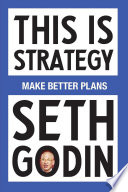

In 'This Is Strategy', the author emphasizes that strategy is not merely about setting goals or pursuing opportunities; it fundamentally revolves around making choices that define a company's direction. The essence of strategy lies in deciding what to pursue and what to forgo, which creates a unique position in the marketplace. This involves understanding the competitive landscape, identifying core competencies, and aligning resources to support strategic objectives. The author argues that without a clear strategy, organizations can easily drift, losing focus and competitive advantage. Therefore, establishing a coherent strategy is crucial for long-term success.
Continue readingThe book discusses the importance of competitive advantage in formulating a successful strategy. Competitive advantage refers to the attributes that allow an organization to outperform its competitors. The author highlights various types of competitive advantages, such as cost leadership, differentiation, and niche focus. By leveraging these advantages, companies can create value for customers and sustain profitability. The key takeaway is that understanding and cultivating competitive advantages is essential for any organization aiming to thrive in a competitive environment.
Continue readingThe author introduces several strategic frameworks and tools that can help organizations analyze their environment and make informed decisions. Tools such as SWOT analysis, Porter’s Five Forces, and the Value Chain Model are discussed in detail. These frameworks provide structured approaches to evaluate internal capabilities and external market conditions. By applying these tools, organizations can identify opportunities, assess threats, and develop strategies that align with their strengths and market demands. The emphasis is on the practical application of these frameworks to inform strategic planning.
Continue readingA critical theme in 'This Is Strategy' is the relationship between strategy and execution. The author argues that even the best strategies can fail if not executed effectively. Execution involves translating strategic plans into actionable steps, aligning teams, and ensuring that resources are allocated efficiently. The book highlights the need for strong leadership and a culture that supports strategic initiatives. It also discusses the role of performance metrics in tracking progress and making necessary adjustments. Ultimately, the author underscores that successful strategy is as much about doing as it is about planning.
Continue readingIn a rapidly changing business environment, adaptability is crucial for sustaining competitive advantage. The author emphasizes the need for organizations to be flexible and responsive to market dynamics. This involves fostering a culture of continuous learning and innovation, where teams are encouraged to experiment and adapt their strategies based on feedback and new information. The book discusses examples of companies that have successfully navigated change by embracing adaptability, illustrating that being proactive rather than reactive can lead to long-term success.
Continue readingThe book stresses the importance of engaging stakeholders in the strategic process. Stakeholders include customers, employees, investors, and the community, all of whom play a significant role in the success of an organization. The author argues that understanding the needs and expectations of stakeholders is vital for developing strategies that resonate with them. By involving stakeholders in decision-making and maintaining open communication, organizations can foster loyalty and support, which are essential for executing strategies effectively.
Continue readingThe final key idea in 'This Is Strategy' revolves around the evolving nature of strategy in the face of technological advancements and globalization. The author discusses how digital transformation and the rise of data analytics are reshaping strategic planning. Organizations must leverage technology to gain insights, improve decision-making, and enhance customer experiences. The book concludes with a call for leaders to embrace a forward-thinking mindset, continuously reevaluating their strategies to remain relevant in a fast-paced world.
Continue reading